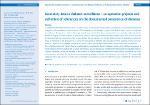Secondary data in diabetes surveillance – co-operation projects and
definition of references on the documented prevalence of diabetes
Schmidt, Christian
Heidemann, Christin
Rommel, Alexander
Brinks, Ralph
Claessen, Heiner
Dreß, Jochen
Hagen, Bernd
Hoyer, Annika
Laux, Gunter
Pollmanns, Johannes
Präger, Maximilian
Böhm, Julian
Drösler, Saskia
Icks, Andrea
Kümmel, Stephanie
Kurz, Christoph
Kvitkina, Tatjana
Laxy, Michael
Maier, Werner
Narres, Maria
Szecsenyi, Joachim
Tönnies, Thaddäus
Weyermann, Maria
Paprott, Rebecca
Reitzle, Lukas
Baumert, Jens
Patelakis, Eleni
Ziese, Thomas
In addition to the Robert Koch Institute’s health surveys, analyses of secondary data are essential to successfully developing
a regular and comprehensive description of the progression of diabetes as part of the Robert Koch Institute’s diabetes
surveillance. Mainly, this is due to the large sample size and the fact that secondary data are routinely collected, which
allows for highly stratified analyses in short time intervals. The fragmented availability of data means that various sources
of secondary data are required in order to provide data for the indicators in the four fields of action for diabetes surveillance.
Thus, a milestone in the project was to check the suitability of different data sources for their usability and to carry out
analyses. Against this backdrop, co-operation projects were specifically funded in the context of diabetes surveillance.
This article presents the results that were achieved in co-operation projects between 2016 and 2018 that focused on a
range of topics: from evaluating the usability of secondary data to statistically modelling the development of epidemiological
indices. Moreover, based on the data of the around 70 million people covered by statutory health insurance, an initial
estimate was calculated for the documented prevalence of type 2 diabetes for the years 2010 and 2011. To comparably
integrate these prevalences over the years in diabetes surveillance, a reference definition was established with external
expertise.
Files in this item

